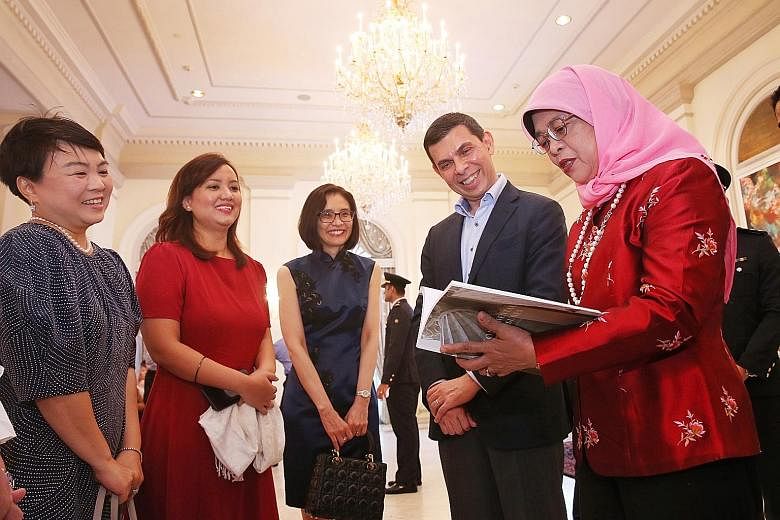Offering a glimpse into the history and heritage of Singapore - from places of worship to schools, museums and commercial buildings - a book dedicated to Singapore's national monuments was launched at the Istana yesterday.
The 288-page publication, Monumental Treasures: Singapore's Heritage Icons, features stories and photos of 72 national monuments and the communities behind them.
Edited by ST heritage and community correspondent Melody Zaccheus and designed by executive multimedia designer Sally Lam, the book features sites dating back up to almost 200 years, including the Istana, National Museum of Singapore, and Changi Prison's gate, wall and turrets.
It was launched officially by President Halimah Yacob, who said: "National monuments are important to us because they are a treasure trove of history.
"They tell us about our past and connect us to our present and future."
Speaking at the launch, Mr Warren Fernandez, who is ST editor and chairman of Straits Times Press, which published the book, said: "This book is something I have dreamt about and wanted to do for quite some time.
"We needed to do so to tell our readers the history of these buildings. To delve into the stories of how and why these buildings came to be built; to figure out the purpose behind them, and how people lived and played, worked and worshipped in these buildings.
-
Istana turns 150 next year
-
One of Singapore's oldest heritage sites, the Istana, will turn 150 next year. On the sidelines of the launch of Monumental Treasures: Singapore's Heritage Icons, President Halimah Yacob announced that there will be a series of events and activities to commemorate this landmark anniversary.
She said the Istana reflects much of Singapore history, and hoped Singaporeans would get involved in the events and activities planned for the milestone year.
The President's residence is built in a combination of European and Malay styles, featuring materials that are sourced locally and in the region, such as stone and granite from Pulau Ubin and marble from neighbouring countries such as Indonesia.
Madam Halimah said: "The history of the Istana actually mirrors Singapore's history and development. It started off as a nutmeg plantation, and then it became the government house for the British and when the Japanese came in, it became their headquarters."
Madam Halimah added that the grounds are used to host foreign dignitaries and is known around the world. She said the Istana is a significant part of Singapore's identity.
It hosts the swearing in of Cabinet members and judges, and even hosts scholarship ceremonies and awards.
The Istana's grounds open to the public several times a year on specific public holidays.
Madam Halimah said that while she is unable to announce any plans for the commemoration yet, she hopes it will be able to include as many Singaporeans as possible.
Cheow Sue-Ann
"I have always felt that we need to know our past to better understand our present, and to help us chart our way forward."
"The team has put in a monumental effort and come up with quite a treasure," added Mr Fernandez, who is also editor-in-chief of the English/Malay/Tamil Media Group at Singapore Press Holdings.
Monumental Treasures, which is supported by the National Heritage Board, contains stories written by 34 Straits Times reporters.
Among them is that of a frantic British Lieutenant-General Arthur Percival burning documents at the Command House at 17 Kheam Hock Road on Feb 14, 1942 - the day before he signed the country's surrender documents at the Ford Factory in Upper Bukit Timah Road, marking Singapore's fall to the Japanese and three years of occupation.
The book also highlights aspects of each monument that are worth exploring and little-known facts.
Ms Zaccheus said: "The visually arresting publication is the perfect gift for a visiting guest, and a must-have for every Singaporean household. The hope is for readers to embark on their own monumental journeys and to help Singaporeans uncover their own love for the country's streets and monuments, and to share these stories that make us who we are."
The book is available at all leading bookstores for $42.70 (inclusive of GST).
Correction note: This story has been edited for clarity



